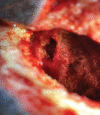Iliocostalis Muscle Rotational Flap: A Novel Flap for Esophagopleural Fistula Repair
- PMID: 35186613
- PMCID: PMC8849421
- DOI: 10.1097/GOX.0000000000004007
Iliocostalis Muscle Rotational Flap: A Novel Flap for Esophagopleural Fistula Repair
Abstract
Intrathoracic fistulas present major challenges to reconstructive surgeons. Reconstruction with muscle flaps have been shown to improve patient outcomes; however, there are patients for whom one or more of the commonly used muscle flaps is not available for several reasons. We describe the use of an iliocostalis muscle rotational flap for the repair of a caudally located esophagopleural fistula in the setting of definitive chemoradiotherapy for treatment of nonsmall-cell lung cancer and reirradiation with photons for local recurrence 5 years later. Our repair remained intact through the nearly 12-month follow-up period during which the patient tolerated a regular diet. This report demonstrates that the iliocostalis lumborum muscle is a viable option for repair of intrathoracic fistulas that are located in the distal esophagus, even in the setting of previous thoracotomy and radiation, and should be part of the reconstructive surgeon's armamentarium in the management of intrathoracic fistulas.
Copyright © 2022 The Authors. Published by Wolters Kluwer Health, Inc. on behalf of The American Society of Plastic Surgeons.
Figures




References
-
- Shen KR, Allen MS, Cassivi SD, et al. . Surgical management of acquired nonmalignant tracheoesophageal and bronchoesophageal fistulae. Ann Thorac Surg. 2010;90:914–918; discussion 919. - PubMed
-
- Liberman M, Cassivi SD. Bronchial stump dehiscence: update on prevention and management. Semin Thorac Cardiovasc Surg. 2007;19:366–373. - PubMed
-
- Asaad M, Van Handel A, Akhavan AA, et al. . Muscle flap transposition for the management of intrathoracic fistulas. Plast Reconstr Surg. 2020;145:829e–838e. - PubMed
-
- Bertheuil N, Duisit J, Isola N, et al. . Perforator-based intercostal artery muscle flap: a novel approach for the treatment of tracheoesophageal or bronchoesophageal fistulas. Plast Reconstr Surg. 2021;147:795e–800e. - PubMed
Publication types
LinkOut - more resources
Full Text Sources
